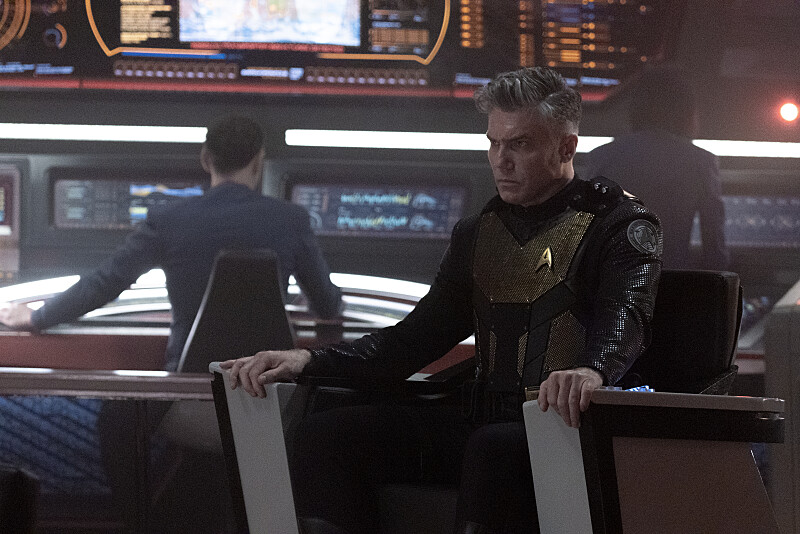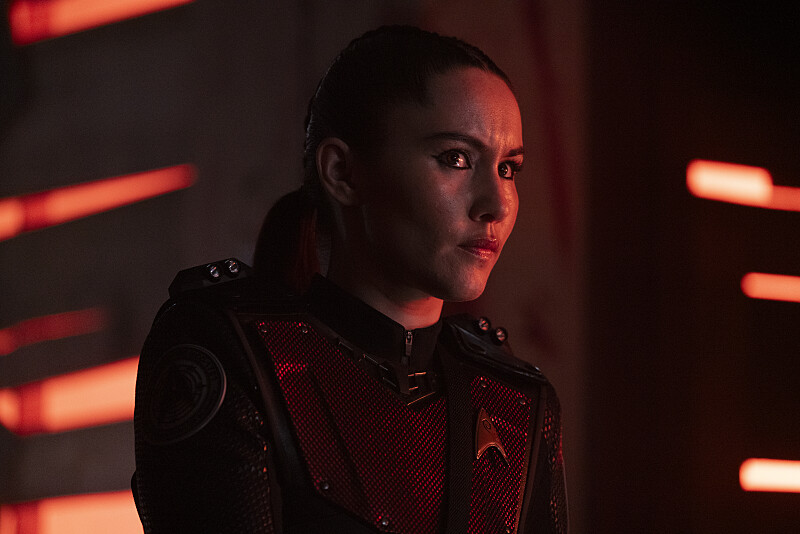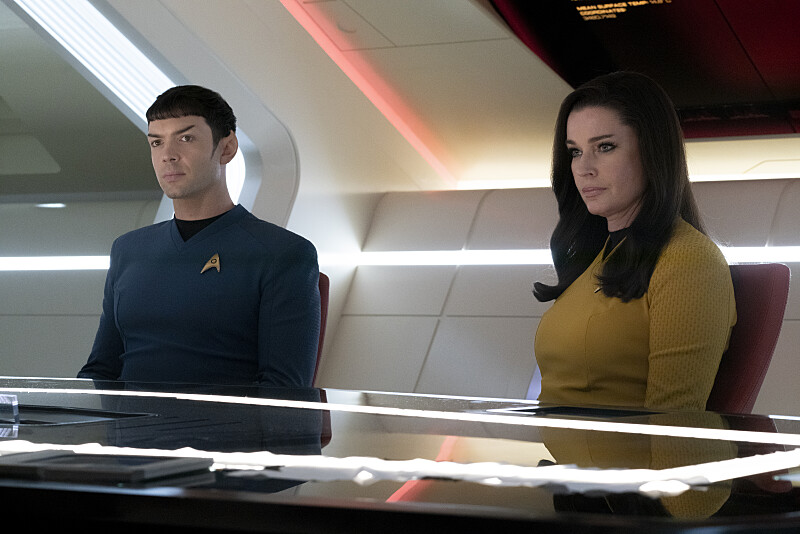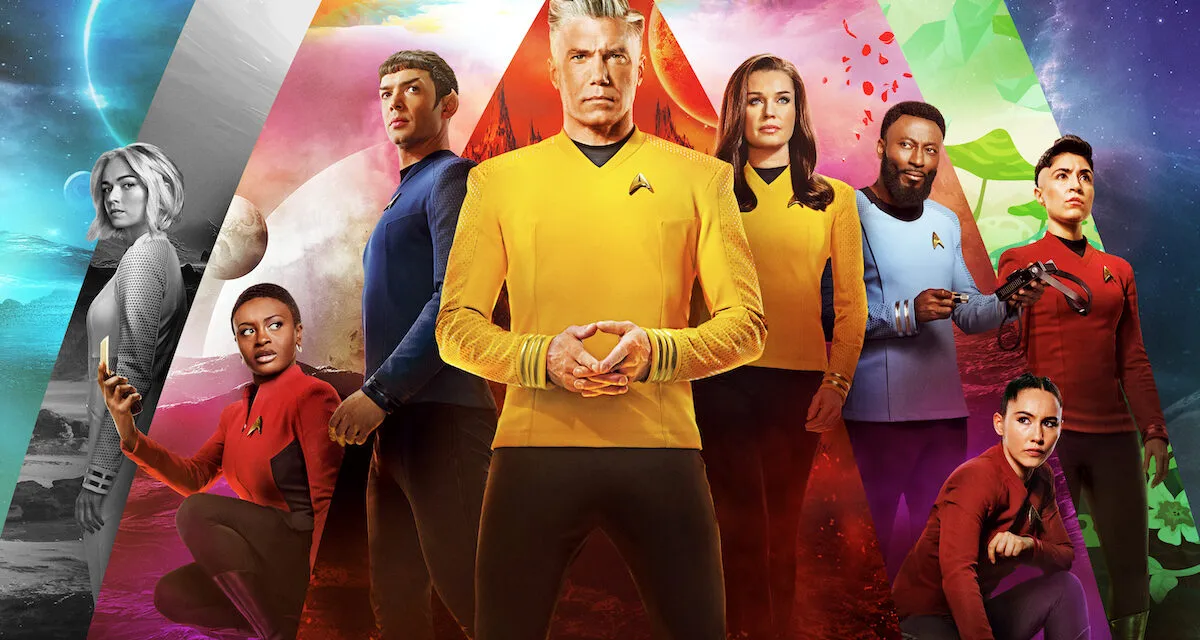This discussion and review contains spoilers for Star Trek: Strange New Worlds season 2, episode 10, the finale, “Hegemony,” on Paramount+.
With Strange New Worlds defined by its nostalgia for The Next Generation and Voyager, it’s no surprise the season finale ends with a cut to black and three words: “To Be Continued.”
Of course, “A Quality of Mercy” ended on its own cliffhanger, with Captain Marie Batel (Melanie Scrofano) serving an arrest warrant for Commander Una Chin-Riley (Rebecca Romijn), but that wasn’t a true two-parter. Leaving aside that the resolution of that cliffhanger was left until “Ad Astra Per Aspera,” the second episode of the subsequent season, it wasn’t a development that built organically from the narrative of the first season finale.
In contrast, “Hegemony” is a more traditional first half of a season-bridging two-parter, evoking episodes like “The Best of Both Worlds,” “Descent,” “Scorpion,” or “Equinox.” It ends at the height of the action. There is no way that the third season of Strange New Worlds can start without directly following on from those closing moments in that high-stakes combat situation, with Captain Christopher Pike (Anson Mount) making that impossible choice.
It’s a sequence very directly evocative of the closing moments of “The Best of Both Worlds,” right down to its framing. In the closing moments of “The Best of Both Worlds,” the crew of the Enterprise turns to Commander William Riker (Jonathan Frakes) for instruction during a stand-off with the Borg. In one of the franchise’s great shots, the camera pushes in on his face as he makes a decision that could kill his mentor, Captain Jean-Luc Picard (Patrick Stewart). He gives the order: “Fire.”

L-R Rong Fu as Mitchell, Rebecca Romijn as Una, Ethan Peck as Spock and Anson Mount as Capt. Pike in Star Trek: Strange New Worlds streaming on Paramount+, 2023. Photo Credit: Michael Gibson/Paramount+
It’s one of the best moments in the history of the Star Trek franchise, and a large part of that is down to the care with which director Cliff Bole frames that sequence. The final shot of the episode begins with Riker standing beside Commander Shelby (Elizabeth Dennehy). It underscores that he has a crew and a support structure. However, as the camera pushes in, it moves Shelby out of the shot. It stops right before Lieutenant Worf (Michael Dorn) would become visible over Riker’s left shoulder.
It’s masterful visual storytelling, and a reminder that television directors have long been undervalued within the industry, particularly those working within the constraints of syndicated or network television. In that one perfect shot and with a very simple camera movement, Bole manages to illustrate the emotional core of that cliffhanger. Riker might be surrounded by his subordinates, but at that moment he is completely alone. It’s all on him.
“Hegemony” is clearly intended to evoke that classic moment, and it’s easy to understand why it would want to. “The Best of Both Worlds” was arguably the moment when The Next Generation truly came into its own, stepping firmly outside the shadow of the original Star Trek. It was a genuine cultural phenomenon, to the point that Patrick Stewart remembers random strangers chastising him for the cliffhanger in the months that followed, “You have ruined our summer!”
The problem, of course, is that “The Best of Both Worlds” was so effective and so successful because it was doing something that Star Trek had never done before. It was the franchise’s first season-ending cliffhanger. It is impossible to replicate that sensation simply by replaying some of the same beats. For Strange New Worlds to truly earn its “Best of Both Worlds” moment, it would have to do something to push itself out of the shadow of The Next Generation and Voyager.
More than that, “Hegemony” is clumsy in its invocation of that moment. During a confrontation with the Gorn, the crew are caught between their mission to rescue the survivors of Parnassus Beta and Starfleet’s orders to withdraw. As in “The Best of Both Worlds,” the closing shot is a close-up pressing in on the lead’s face. However, “Hegemony” doesn’t stage its shot as artfully. The visual storytelling is not as graceful, perhaps because the episode doesn’t arrive at it organically, but simply as homage.

L-R Ethan Peck as Spock and Anson Mount as Capt. Pike in Star Trek: Strange New Worlds streaming on Paramount+, 2023. Photo Credit: Michael Gibson/Paramount+
As the first part of a two-parter, it is difficult to properly unpack “Hegemony.” The narrative’s resolution will come in the second episode, and it’s unclear if the writing staff had that second part mapped out while drafting this episode. Famously, writer Michael Piller had no idea how he was going to resolve that “Best of Both Worlds” cliffhanger. He was considering leaving the show at the time, and so the conclusion would become somebody else’s problem.
Still, “Hegemony” returns to one of the recurring threads seeded through the first two seasons of Strange New Worlds: the Gorn Hegemony. The reptilian menace were established as the show’s primary antagonists in first season episodes like “Memento Mori” and “All Those Who Wander.” They have lurked in the background of the second season, from the closing image of the season premiere, “The Broken Circle,” through to the justification for Starfleet’s expansion in “Lost in Translation.”
One of the big issues with the use of the Gorn in Strange New Worlds is that their first appearance in Star Trek, “Arena,” was largely about James T. Kirk (William Shatner) coming to realize that these lumbering alien creatures were not really monsters. Like other Gene L. Coon episodes, such as “The Devil in the Dark,” the central point of the Gorn was to argue that empathy should extend beyond a creature’s outward appearance — that those who look different are not inherently evil.
To its credit, “Hegemony” acknowledges that argument. In the opening sequence, Admiral Robert April (Adrian Holmes) cautions Pike, “I think it’s safe to say that we don’t understand the Gorn.” Pike replies, “Well, I’ve seen them up close and personal, and they’re not hard to understand, Bob. They’re monsters.” April counters, “Monster is a word used to describe those that don’t understand us.” Pike insists, “And sometimes a monster’s just a monster.”
It is entirely possible — likely, even — that Strange New Worlds is building to a moment where Pike realizes that the Gorn are not monsters, just a different culture. There are indications of that within “Hegemony.” Lieutenant La’an Noonien-Singh (Christina Chong) is shocked by the behavior of the creatures. “They should be fighting for dominance, not working together,” she opines. Pike wonders, “Maybe instead of finding a way to fight them, we find some way to… reach them.”

Christina Chong as La’an in Star Trek: Strange New Worlds streaming on Paramount+, 2023. Photo Credit: Michael Gibson/Paramount+
This makes a certain amount of sense. In the words of Star Trek writer Garfield Reeves-Steven, “The story of Star Trek is how our enemies become our friends.” However, there are two big problems with this. The first problem is that it would be extremely disappointing if it took Strange New Worlds more than two seasons to reach a conclusion about the Gorn that Star Trek reached in 50 minutes. The second is the sense in which Strange New Worlds revels in the Gorn’s monstrosity.
There is a bloodlust running through “Hegemony,” and it is not framed with the same ambiguity that made “Under the Cloak of War” so compelling. Instead, the episode seems to celebrate the crew’s desire to hunt and kill Gorn. They are “an armada of human-eating lizards.” They move like “a swarm,” with Samuel Kirk (Dan Jeannotte) comparing them to “locusts.” It’s rhetoric that comes very close to James T. Kirk’s description of the Klingons as “animals” in Star Trek VI: The Undiscovered Country.
“I’d appreciate another chance to study them up close,” Sam Kirk tells Pike in the mission briefing. “With a phaser?” Noonien-Singh inquires. “How else will we determine how best to kill them?” answers Kirk, who is the ship’s xenoanthropologist. “I would like to aid in that study,” adds Joseph M’Benga (Babs Olusanmokun), the ships’ doctor. Pike then instructs the crew to arm themselves, as Nami Melumad’s score hits the classic Star Trek fanfare.
There is no discomfort or unease here, as the crew load up with what Lieutenant Erica Ortegas (Melissa Navia) describes as “super cool toys.” There is no hesitation when Noonien-Singh ambushes “a Gorn youngling” in the street, effectively executing a child. It’s all played as thrilling spectacle. After all, the sequence of Ortegas piloting the shuttle into the atmosphere of Parnassus Beta, dipping below the treeline before recovering, was the big opening beat in the season’s trailer. It’s visceral and exciting.
The implication seems to be that the Gorn are largely mindless animals driven by instinct, guided by the coronal mass ejections of large solar bodies. However, nobody on the Enterprise stops to wonder how a species without higher reasoning could have built spaceships or space suits, or mastered the faster-than-light travel necessary to compete with the Federation. For a ship ostensibly on a mission of peaceful exploration, there is a frustrating lack of curiosity at play here.

L-R Ethan Peck as Spock and Rebecca Romijn as Una in Star Trek: Strange New Worlds streaming on Paramount+, 2023. Photo Credit: Michael Gibson/Paramount+
Despite its obvious nostalgia for the Star Trek of the 1990s, the pop culture of “the end of history,” and “the unipolar moment,” “Hegemony” suggests that Strange New Worlds is still a product of the War on Terror that has shaped every Star Trek since Enterprise. It might hide that sensibility beneath a polished nostalgic exterior, but it is still there. Indeed, Spock’s (Ethan Peck) flight through the debris field consciously evokes a similar sequence in the War-on-Terror-adjacent Star Trek Into Darkness.
Indeed, these parallels become particularly pronounced as the crew separately plot to take down a Gorn tower blocking communications and transporters. Nobody suggests sabotaging or overriding the tower. Instead, these characters separately plan aerial attacks. On the ground, Batel plans to take a shuttle, “fly it into the Gorn tower, destroy it.” On the Enterprise, Uhura (Celia Rose Gooding) hopes to “find a way to get a piece of debris large enough to survive re-entry to crash into that structure.”
These are both suicide missions. Batel would fly the shuttle herself. While Spock sets the saucer of the Cayuga on autopilot, it is entirely possible that there are other survivors on board. He isn’t aware of Christine Chapel’s (Jess Bush) survival until she comes to the bridge, after all. Like the Vengeance crashing into San Francisco in Into Darkness, it is a reminder of how shaped American pop culture still is by 9/11. In fact, this is very similar to how 1980s pop culture dealt with the Vietnam War.
In its own way, “Hegemony” is a reminder of the central paradox of Strange New Worlds, an episode built around the fundamental and inescapable reality that it is no longer the 1990s, no matter how hard one might wish otherwise.






Published: Aug 10, 2023 09:35 am